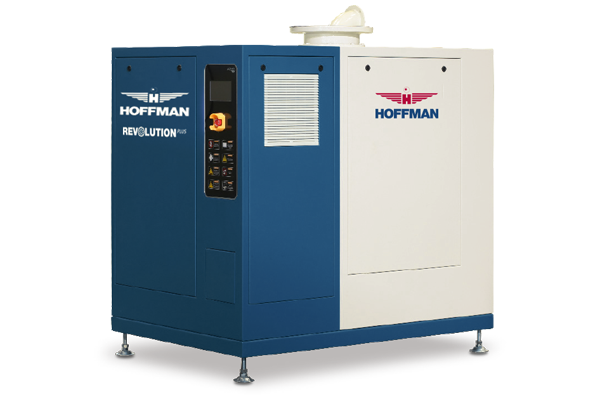Choose a different country or region to see the content specific to your location
Select Your Country/Region
Current Region:
 Global (EN)
Global (EN)
Choose a different country or region to see the content specific to your location
Current Region:
 Global (EN)
Global (EN)
How can we help you?
In this article, we will uncover what a high-speed turbo blower is, how it works, and the applications that are best suited for high-speed turbo blower technology.
High-speed turbo blowers deliver maximum performance by packaging a single stage centrifugal blower with advanced energy management systems. The combination provides an efficient package that is designed to deliver superior efficiency for wastewater and general industrial applications.
High-speed turbo blowers rely on aerodynamic air-foil bearings. Unlike traditional ball bearing based systems, air foil bearings utilize the high rotational speeds generated by the motor to create a pressurized film of air around the bearing shaft. This ensures that there is no contact between the shaft and the bearing housing.
Therefore, allowing air foil bearings to avoid some of the issues faced by ball bearing based systems. Issues such as the constant need for service and lubrication; allowing them to maximize performance, and reduce equipment downtime.

Our high-speed turbo blowers use innovation and advanced technology delivering energy savings of up to 40%. These turbo blowers provide increased reliability with low maintenance requirements and are factory prewired and tested in an ergonomically designed sound enclosure for plug-and-play operation.
High-speed turbo blowers follow the compression principle of the centrifugal compressor, or dynamic compressor with a radial design. It works at constant pressure with performance depending on external ambient conditions delivering compressed air without pulsations.
Air is drawn axially into the center of the impeller with radial blades and is pushed radially by means of centrifugal force. The rotation of the impeller accelerates the speed of air (kinetic energy), and forces it to pass through the downstream diffusers and volute. The high kinetic energy is converted into potential energy (pressure).
Therefore, slowing down the speed of the air through expansion. The velocity energy is converted into pressure energy, where pressure is inversely proportional to velocity squared (Bernoulli’s principle).
The optimal operation of a turbo blower is achieved when the blower is performing within its specified range of air flow. Maximum efficiency for turbo blowers is a product of pressure and air flow, and is limited by surge and choke.
Surge is the reversal of flow within the dynamic compression process. It takes place when the capacity being handled is reduced to a point where insufficient pressure is being generated to maintain flow. This means that as the flow travels through the compressor, the pressure has reached the maximum limit of the compressor impeller that it can push against.
Since the compressor cannot overcome the pressure, the air flow slips backward rather than being pushed into the system. This leads to vibrations that can potentially damage internal components. To prevent such occurrences, the bypass valve (Blow-Off valve) is open before reaching the surge point.
High-speed turbo blowers have permanent magnet synchronous motors (PMSM). These provide a much higher operational velocity, output, and performance than traditional induction motors.
PMSMs are powered by an alternating current that is run through the stator coils to create a rotating magnetic field, while fixed permanent magnets attached to the rotor create a constant magnetic field. At a synchronous speed, the poles generated by the rotor’s magnets lock onto the magnetic field generated by the stator, causing the rotor to turn in sync with the frequency of the current running through the stator.
This allows PMSMs to operate without any ‘slip’ or ‘lag’ in the rotor, making them inherently more efficient than traditional induction motors. Providing a direct connection to the blower’s impeller, PMSMs ensure no power loss, regardless of the blower's operating speed or conditions.
All HOFFMAN high-speed turbo blowers are fitted with a VSD (variable speed drive) as standard. The VSD adjusts the PMSM motor’s operating speed to meet operational requirements. Allowing operators to tailor the performance to meet oxygen demand, which further increases the levels of efficiency that they can provide.
Over time, equipment maintenance requirements, parts, and spares, as well as downtime and process upsets can impact the total cost of ownership and operational costs. That is why it is crucial to select equipment that meets efficiency requirements and is designed to withstand the process and environmental demands.
HOFFMAN’s REVOLUTIONPLUS combines an advanced blower management system with a significantly smaller physical footprint than traditional blowers to set a new standard for blower design, performance, and efficiency.
The REVOLUTIONPLUS uses innovation and advanced technology to deliver energy savings of up to 40%; increased reliability with little to no maintenance, and comes factory pre-wired and tested in an ergonomically designed sound enclosure for plug-and-play operation.
High-speed turbo blowers serve a wide range of wastewater treatment & industrial process applications, click the cards below to discover more!
The REVOLUTIONPLUS combines precision machined components with innovative, advanced technology such as a high-speed, direct coupled motor, and state-of-the-art air foil bearings, to deliver energy savings of up to 40%. Engineered for maximum reliability, the REVOLUTIONPLUS provides virtually maintenance-free operation. With no belt, no gears, and no oil, maintenance is reduced to quick and simple filter changes and periodic inspections; minimizing downtime and reducing operating costs.
ABOUT Hoffman™ and Lamson™
Hoffman™ and Lamson™ brands of centrifugal blowers and exhausters are among the many compressed air and gas technologies manufactured by Gardner Denver Inc.
Part of the Nash Division, they are American originals. Hoffman™ and Lamson™ brands have been setting industry standards for excellence, reliability, and customer satisfaction for over 100 years. Lamson, established in 1880, and Hoffman, in 1905, are brands customers know and continue to trust.